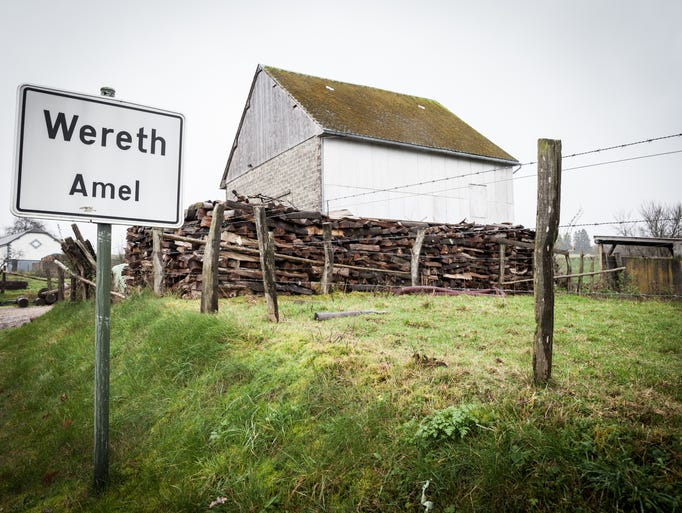SS troops apprehended them from Langer's family farm house after being tipped off by a German sympathizer. Langer never forgot the look of fear in the soldier's faces as they were captured and led away, as reported by usatoday.com
 |
| Captured members of the 333rd Field Artillery Battalion were used in Nazi Propaganda Films Source: 40daysofhonor.com |
Over 50 years later, in 1996, Hermann Langer left a cross on the site as a tribute to the soldiers that his family housed. His makeshift memorial was discovered by historians. Most of the world was unfamiliar of the story, until the nineties, when amateur military buffs, journalists, and family members of the soldiers joined forces to discover what happened on that fateful day many years ago. Family members of the Wereth 11, as they were known, were told that they died in combat, not tortured and executed. (history.net)
Thanks to the efforts of eyewitness Hermann Langer, the world now knows the truth of what happened to the Wereth 11.
Battle of the Bulge
(December 16, 1944 - January 25, 1945)
The Battle of the Bulge was a secret offensive launched by Adolf Hitler to splinter the British and American Allies via the Ardennes region of Belgium, France and Luxembourg. Hitler's objective was to decimate defenders, forcing the Allies to sign a treaty. This would allow Hitler to concentrate his energies on the Eastern Front. Originally, the Germans were at an advantage in the early stages of the battle. Heavy casualties were sustained with this World War II battle ranking as the deadliest for Americans, according to armymilitary.com.
Personnel of the segregated Army's 333rd Field Artillery Battalion were obliterated by death or capture.* Somehow, 11 soldiers of the 333rd manage to escape. They traveled through the snow for miles and arrived at the Langer farmhouse. It just so happened that the Langer Home was a haven for German Army deserters, and owner Mathias Langer was anti-war. The Langers risked their lives by housing the African American Soldiers. (40daysofhonor.com)
The Soldiers were captured by the German Army and forced to run in the extreme cold at gunpoint. Meanwhile, the Battle of the Bulge waged on with the Allies gaining the advantage. Change in tactics and reinforcements stopped the Germans from advancing, and it was the last time Hitler waged an offensive against the west, purports armymilitary.com. Townspeople remained inside their homes out of harm's way for months. February 1945 yielded this gruesome discovery : Hands were spotted from underneath the snow. The Wereth11 Soldiers had been left to die without a proper burial. (40daysofhonor.com)
The Wereth 11 Soldiers were deliberately abused and killed, rather than taken Prisoners of War. It was a blatant violation of the Geneva Convention as the German soldiers had no intentions of placing the captured men in a camp. Usatoday.com describes how the Wereth 11 Soldiers were stabbed repeatedly with bayonets, and struck in their heads with a rifle. A surgeon's report mentions a finger almost severed.
Which brings us to the Wereth Memorial. Because of Hermann Langer's makeshift memorial as an adult, his heartfelt actions generated interest in the African American Soldiers of the 333rd. The Wereth Memorial was erected in 2004 in Wereth, Belgium. It is the first memorial of its kind in Europe--a Memorial dedicated to the contributions of all African Americans G.I.'s and segregated units that served in World War II. (werethmemorial.org)
 |
| The site where 11 Black soldiers were captured by German troops. Source: usatoday.com |
Winston Churchill remarked that the Battle of the Bulge was "one of the greatest battles of the war," as stated in armymilitary.com. When official reports on the various German atrocities were revealed, the Wereth 11 were omitted. A resolution by Congress, and memorials in the US finally shed light on the Black Soldiers decades later. Wereth 11, a documentary released in 2011, depicted the heinous massacre of African American Soldiers. It won a prestigious G.I. Film Festival Award.
To conclude, the Wereth 11 represent yet another group of African Soldier's whose story was untold. They were members of the United States Army's 333rd Field Artillery Battalion, a segregated unit known for its marksmanship. A gesture by a witness, the combined efforts of historians, journalists and family members brought their story to the media. The Wereth 11 Memorial in Belgium is a tribute to these Soldiers of segregated units, and draws international visitors.
I included the Wereth 11 story because of the similarities to the Montford Point Marines. They were unsung heroes and represented the tremendous sacrifice made by a segregated military unit. Below are names of the Wereth Soldiers. Note that every single Soldier was from the South, where segregation was the law of the land.
They died defending America from Hitler, but were second class citizens at home.
The 11 soldiers massacred, known as the "Wereth 11", were: Curtis Adams of South Carolina; Mager Bradley of Mississippi, George Davis Jr. of Alabama; Thomas Forte of Mississippi; Robert Green of Georgia; James Leatherwood of Mississippi; Nathaniel Moss of Texas; George Motten of Texas; William Pritchett of Alabama; James Stewart of West Virginia; and Due Turner of Arkansas (40daysofhonor.com).
 |
| Wereth 11 Motion Picture Source: Amazon.com |
* 40daysof honor.com states that the 333rd were known for excellent marksmanship. They once hit a target dead on that was 9 miles away.
40daysofhonor.com
Battle of the Bulge
usatoday.com
The Wereth 11, A Little Known Massacre
wereth.org
wvaculture.org